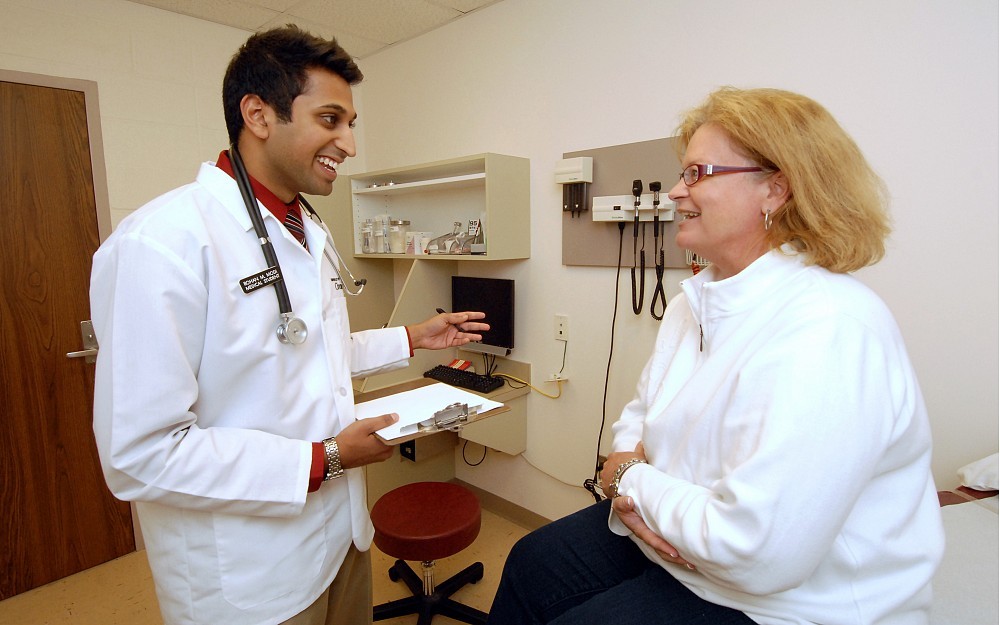
New Curriculum in Place at the College of Medicine
When incoming UC medical students took their class oath on Aug. 12, 2011, they pledged to "adapt with a changing environment." It seems fitting for the class of 2015 to make this pledge as we mark the first year of a new curriculum at the College of Medicine. One of the most appreciable changes in the curriculum is the integration of hands-on clinical training in the first year. On the first day of class, students immediately participate in First Responder training. By week three, first-year students are engaged in learning the basics of medical history taking and physical exam skills. "The new curriculum allows students to put on their white coat and engage in clinical medical training from the moment that they walk through the door, says Anne Gunderson, EdD, associate dean for medical education. She continues below...
Why did the curriculum need to change?
"Health care is a complex and rapidly changing environment. Medical schools are being challenged to produce physicians capable of successfully navigating complex health care systems and coping with exponentially increasing biomedical knowledge, all in the face of diminishing resources and competing curricular priorities. In this environment, obtaining and sustaining competencies for optimal patient outcomes require knowledge, skills and attitudes not traditionally taught in medical schools.
"The former UC COM medical student curriculum was established in the early 1990s and represented a traditional model consisting of two years of basic science coursework, followed by two years of clinical experiences. In light of significant changes in health care and national trends in medical education, the UCCOM Educational Policy Committee convened a special taskforce to facilitate the development of an integrative curriculum that would prepare physicians for practice in the 21st century."
Was it just a matter of switching courses around?
"The key theme noted during the analysis phase of the curriculum revision process was the need to significantly increase integration of the sciences throughout the medical education program. This concept represents a fundamental shift away from a curriculum that favors acquisition and testing of a very discrete body of knowledge, with little regard to the application of information in a broader format. Adoption of a fully articulated and aligned curriculum is expected to facilitate a student centered curriculum, reduce redundancy and strategically align placement of the basic, clinical and psychosocial sciences across the four years. Additionally, there was a need for increased and specific clinical relevance and experiences in what had traditionally been considered the preclinical years of the curriculum. To provide a framework for the curriculum revision and implementation process, a list of guiding principles was created for the new curriculum."
How long did the process take, and what kind of input did you receive from faculty, administration and staff?
"Improving the quality of medical education through curriculum revision is a continuous process, and UC COM has made important advancements over the past 10 years. Revising the curriculum is not an easy endeavor at any medical school and requires considerable energy, education and careful prioritization of resources. Over the past 20 months, the curriculum revision process has built upon underlying strengths of the existing educational program, identified and improved weak or neglected content domains and has created new learning experiences. In addition to the original taskforce, 5 sub-taskforces and 17 content expert groups have been working in teams to create the new curriculum. This process will continue to expand over the next 3 years.The dedication of faculty members, the partnerships with students,and the commitment of the COM staff has made the initial vision become a reality. Through the tireless and unremitting effort of over 175 students, staff and faculty members, we implemented the new curriculum for the incoming first year class August 15, 2011."
How does the new curriculum make the college more attractive to potential students?
"Medicine, and medical education, must be ever vigilant and respond to evolving societal needs, changes in health care practice patterns and scientific advancements. The new curriculum embraces this challenge and provides a teaching and learning approach that is highly desirable for candidates dedicated to being prepared for practice in todays challenging health care environment. Our commitment to providing early clinical experiences, an integrated contextual learning environment and the development of outstanding, quality driven physicians continues to make UC COM a school of choice."
Since classes are officially in session, have you received any feedback yet?
"The UC COM curriculum leadership team worked hard to ensure that incoming students were aware of the changing curriculum prior to their arrival on campus and the Class of 2015 has been supportive throughout the first weeks of the new curriculum. The overall feedback has been very positive. Similar to the beginning of any academic year, we have experienced unanticipated glitches that were immediately remedied for students and provided learning opportunities for our implementation process. We are looking forward to continuing a strong partnership with the students as we continuously analyze, improve and implement the new four year medical student curriculum."

Anne Gunderson, EdD, Associate Dean for Medical Education
Related Stories
Is ketamine the answer to treatment-resistant depression?
May 16, 2024
The University of Cincinnati's Stephen Rush joined WVXU's Cincinnati Edition to discuss the use of ketamine and esketamine to treat treatment-resistant depression.
UC study: Severe ischemic strokes rare in total patient...
May 15, 2024
The University of Cincinnati’s Yasmin Aziz will present research at the European Stroke Organisation Conference that found severe ischemic strokes with the most severe damage are rare in the total stroke patient population.
Increasing syphilis cases highlight treatment barriers across...
May 14, 2024
The University of Cincinnati's Carl Fichtenbaum spoke with the Cincinnati Enquirer about a recent report that found Hamilton County syphilis cases reached a six-year high in 2023.
